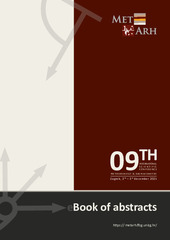Приказ основних података о документу
Application of photogrammetric method of 3D scanning within the shaft Object 1 at the Prljuša-Mali Šturac site
| dc.creator | Pendić, Jugoslav | |
| dc.creator | Dimić, Vidan | |
| dc.creator | Antonović, Dragana | |
| dc.date.accessioned | 2023-11-23T10:24:17Z | |
| dc.date.available | 2023-11-23T10:24:17Z | |
| dc.date.issued | 2021 | |
| dc.identifier.isbn | 978-953-175-963-2 | |
| dc.identifier.isbn | 978-953-6335-21-3 | |
| dc.identifier.uri | http://rai.ai.ac.rs/handle/123456789/811 | |
| dc.description.abstract | Ten years of archaeological research on the Prljuša-Mali Šturac site have shown that on this steep slope of Mt. Rudnik is one of the largest and richest mining sites in Southeast Europe, where malachite was exploited in the period from the Eneolithic to the Bronze Age. Since 2013, the excavations have focused on surface mining open-pits on the central part of the slope (Shafts 4 and 6), while in 2014 the focus shifted to the top of the slope, and, as later research turned out, the imposing shaft Object 1. Over the course of campaigns, a number of nterconnected galleries, hallways, entrances, burning marks, and marks of ore extraction were discovered, alongside over 500 hammerstones. As the works progressed, Object 1 became clearly defined, and plans for the arrangement and presentation of this part of the site were in development. In addition to site arrangement, the plans for the presentation included a 3D reconstruction of Object 1, and then the other shafts that are visible on the slope and whose research has not yet been conducted. The ultimate goal is a successive creation of a collection of 3D digitized prehistoric mining shafts of Prljuša - Mali Šturac that would have a research-presentation character. The first step towards this goal was done in 2019, with the creation of technical documentation of Object 1 through 3D scanning, by terrestrial photogrammetry. During this process, a large number of convergent photographs of the research zone were collected, where all exposed areas, sheltered and covered sections were documented in multiple frames. The primary interest was to deliver complete reconstruction and so-called “ground zero” snap of the situation, for spatial plan development, conservation and presentation of mining structures. The final result of the 3D scan included the creation of a spatial plan of the whole and DMT (Digital Terrain Model) model, as well as a geometrically corrected orthophoto (True Orthophoto), a highly detailed 3D model of the whole, and an optimized view for sharing on online services. This poster presents the final products of this process. The authors believe that the existence of a reference collection of 3D digitized prehistoric mining shafts would be a welcome resource for the explorers, that would provide unique insight, from a new perspective, into the method of exploitation and formation of shafts, their maintenance, abandonment, and backfilling, together with the process of decay and collapsing. | sr |
| dc.language.iso | en | sr |
| dc.publisher | Zagreb : Faculty of Humanities and Social Sciences of the University of Zagreb | sr |
| dc.publisher | Zagreb : Croatian Archaeological Society | sr |
| dc.rights | openAccess | sr |
| dc.source | 9th International Scientific Conference Methodology & Archaeometry, 2nd - 3rd of December 2021, Zagreb | sr |
| dc.subject | Prljuša–Mali Šturac | sr |
| dc.subject | 3D reconstruction | sr |
| dc.subject | Photogrammetry | sr |
| dc.subject | shaft Object 1 | sr |
| dc.subject | 3D scanning | sr |
| dc.title | Application of photogrammetric method of 3D scanning within the shaft Object 1 at the Prljuša-Mali Šturac site | sr |
| dc.type | conferenceObject | sr |
| dc.rights.license | ARR | sr |
| dc.citation.epage | 48 | |
| dc.citation.spage | 48 | |
| dc.description.other | In: Ina Miloglav (ed.), Book of abstracts of 9th International Scientific conference Methodology & Archaeometry, 2nd - 3rd of December 2021, Zagreb, Croatia (pp. 48). Zagreb: Faculty of Humanities and Social Sciences - Department of Archaeology and Croatian Archaeological Society. | sr |
| dc.identifier.fulltext | http://rai.ai.ac.rs/bitstream/id/1842/bitstream_1842.pdf | |
| dc.identifier.rcub | https://hdl.handle.net/21.15107/rcub_rai_811 | |
| dc.type.version | publishedVersion | sr |


